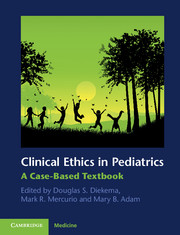Book contents
- Frontmatter
- Contents
- Contributors
- Preface
- Section 1 Core issues in clinical pediatric ethics
- Section 2 Ethical issues at the beginning of life: perinatology and neonatology
- Section 3 When a child dies: ethical issues at the end of life
- Section 4 Ethical issues posed by advances in medical technology and science
- 25 Minors as recipients and donors in solid organ transplantation
- 26 Enhancement technologies and children
- 27 Cochlear implants and deaf children
- 28 Ethical issues in the treatment of pediatric patients with disorders of sex development
- 29 Sterilizing procedures in minors with cognitive disabilities
- 30 Parental requests for intervention in children with lethal conditions
- 31 Genetic testing and screening of minors
- 32 The introduction of innovative technology into practice
- 33 Human subjects research involving children
- Section 5 Children, public health, and justice
- Section 6 Special topics in pediatric ethics
- Index
- References
32 - The introduction of innovative technology into practice
from Section 4 - Ethical issues posed by advances in medical technology and science
Published online by Cambridge University Press: 07 October 2011
- Frontmatter
- Contents
- Contributors
- Preface
- Section 1 Core issues in clinical pediatric ethics
- Section 2 Ethical issues at the beginning of life: perinatology and neonatology
- Section 3 When a child dies: ethical issues at the end of life
- Section 4 Ethical issues posed by advances in medical technology and science
- 25 Minors as recipients and donors in solid organ transplantation
- 26 Enhancement technologies and children
- 27 Cochlear implants and deaf children
- 28 Ethical issues in the treatment of pediatric patients with disorders of sex development
- 29 Sterilizing procedures in minors with cognitive disabilities
- 30 Parental requests for intervention in children with lethal conditions
- 31 Genetic testing and screening of minors
- 32 The introduction of innovative technology into practice
- 33 Human subjects research involving children
- Section 5 Children, public health, and justice
- Section 6 Special topics in pediatric ethics
- Index
- References
Summary
Introduction
Stories of clinical innovation in medicine are generally stories of fits and starts, of irrational exuberance and of avoidable tragedy, of skill, luck, science, and serendipity. Such stories are often transformed, in retrospect, into orderly, semi-fictional narratives that show science as a rational process. These narratives portray medical progress as the result of carefully designed experiments that test specific hypotheses. The results of such experiments, so the story goes, are then incorporated into clinical practice. The real history of innovation is both more fun and more frightening than such myths might suggest.
In the real world, progress is non-linear and messy because every innovation is a frightening gamble. When innovations are first tried, we know little about them. We don’t know whether they will work, for whom, or with what associated harms. We don’t know whether the benefits will ultimately outweigh the risks. We don’t know the comparative effectiveness of innovative and standard therapies. We aren’t even sure exactly when it is ethically permissible to study a new therapy, or which research methodology is best, or when it has been studied enough. Even when good studies are done, it is often hard to interpret the results.
- Type
- Chapter
- Information
- Clinical Ethics in PediatricsA Case-Based Textbook, pp. 186 - 193Publisher: Cambridge University PressPrint publication year: 2011
References
- 1
- Cited by



